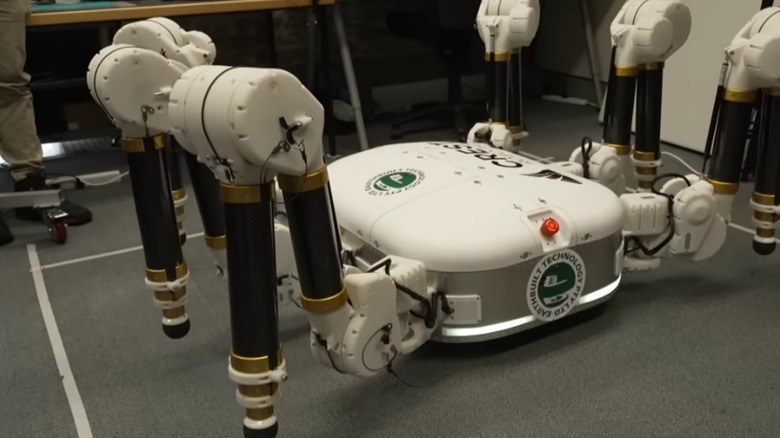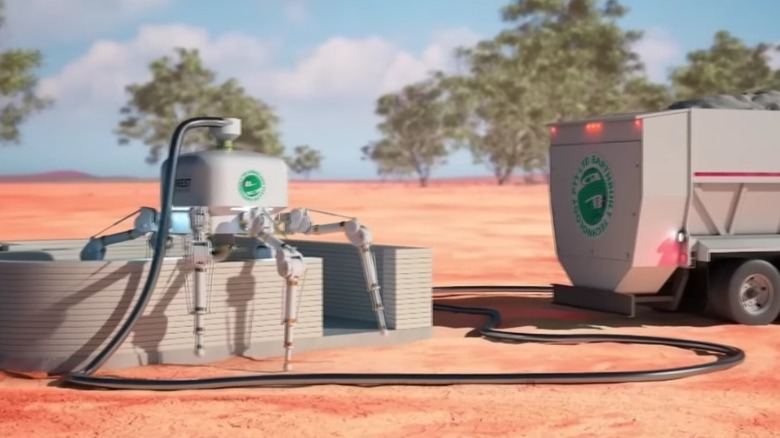No One Wants A Giant Australian Spider In Their Home - But What About One Building It?
Australia, famously, is home to some of the most formidable wildlife on Earth, and its arachnid population is particularly legendary. From the huntsman to the orb-weaver, there are some extraordinary species in the Land Down Under. They're to be respected like any other living creature, but now it seems that potentially the most remarkable Australian spider of all was built, not made. We typically think of mechanical spiders as convertibles, but this is a very different machine. It's a robot that has been named Charlotte, and it's capable of building environmentally-friendly houses.
The robot is a collaboration between Earthbuilt Technology and Crest Robotics, first seen at Sydney's International Astronautical Congress in 2025. Crest Robotics explains that this is not simply a fanciful experiment, but a potential high-tech solution to one of the greatest issues faced by humanity today. The company explains that "A Moon base is critical for further lunar exploration and deep space research, but conventional construction methods are impossible in space." Meanwhile, "on Earth, we are experiencing a housing crisis. Traditional construction is slow, costly, and carbon-intensive." You might not think that a spider robot would be well-equipped to help alleviate both of these problems, but Project Charlotte is unlike any robot we've seen yet. With an advanced 3D printing capacity, a light, resilient design, and special equipment with which to collect even the sorely limited resources on the Moon to make into building materials, Charlotte could have an important part to play in mankind's adventures into space. Let's see exactly what Charlotte's creators hope it can do when it theoretically makes it to space, and in the meantime, how the robot may be able to revolutionize our approach to the housing issues we face down here on terra firma.
24-hour 3D printed homes could be a reality
As anyone in the construction industry would probably tell you, building a quality home in just 24 hours (at least, the outside walls of the structure itself) would seem to be all but an impossibility. The trick Charlotte has up its spidery sleeves, however, is an advanced 3D printing ability. Lots of real spider species, of course, are known for their extraordinary ability to lay intricate and astonishingly strong webs, with a tensile strength potentially higher than that of steel. Charlotte takes a slightly different route to making a home: The robot is designed to place 'layers' of materials, one on top of the others, steadily placing a building as a bricklayer might (though the robot works about 100 times faster according to Fox News). It's all made possible by the versatile way 3d printers work.
To perform this delicate work so quickly, two important things are needed. The first is great dexterity, and the many-legged design of the robot was chosen to help with just that. The second is an easily-replenished supply of raw materials, so that the work doesn't have to keep being interrupted. Crest Robotics explains that its partner's technology comes into play for this part of the process: "Earthbuilt's extrusion system will collect readily available materials such as sand, earth and waste products like crushed brick, which are then bound in fabric and compressed to form the layers of a building." Not only does this make it abundantly clear that they're leaning into the whole spider thing with this way of operating, but it also lends a simplicity and elegance to the whole process. It's all very self-contained, and that's going to be of even greater importance when it comes to the particularly challenging environment of space.
To infinity, and beyond
Charlotte uses a new take on a system known as earthbag building. This method is, essentially, exactly what it sounds like: building a structure from bags of earth. It's cheap and sustainable, plus, crucially, much more robust than you might think. The creator of Earthbag building, Nader Khalili, suggested to NASA that astronauts may be able to use just such a technique, which led to constructing a mocked up lunar colony in Hesperia, CA. The idea is that Charlotte, an autonomous robot, could potentially perform work very similar to this across Australia, and on the Moon itself.
Crest Robotics Founding Director Dr. Clyde Webster spoke to ABCNEWSRadio, and explained that it's taken this technique to the next level by automating the process. This is particularly important, because a major drawback of earthbagging is that it has been a very involved process. Charlotte, it seems, is able to perform this duty far faster. "At Crest, that's what we do, we try to take the danger out of hard work with advanced tools and robotics," Dr. Webster told presenter Sarah Morice. Addressing concerns that such technology could result in job losses among workers, he added, "we can actually increase accessibility of these jobs to the broader community. We should have more work, we should have safer work."
For now, Charlotte's true capabilities are theoretical. Crest Robotics notes that it is "looking for collaborators to develop, test and scale this new way of building homes," indicating that the technology is in its early stages and there's no space trip imminent. The robot has been prepared for just that, though, designed to be conveniently stored away for such a journey. In the future, it might be up there along with projects such as Toyota's lunar cruiser.


